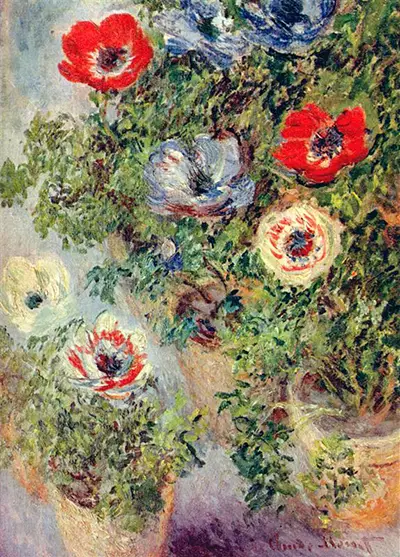What strikes you immediately is the vibrancy of the colours and how skilfully a limited range of hues are applied in unadulterated form to the canvas.
It was Monet's urge to commit the natural world to canvas as spontaneously as possible to seize the moment and capture the special quality of the light.
It is estimated that Monet painted or drew at least 2,500 pieces of art although because many were destroyed the actual figure is unknown.
Typical of an impressionist artist, Monet uses short bold brush strokes and by adding layers of colour, the red anemones become more intense dominating the picture.
This effect is increased by the sharp delineation of the petals. The two flowers below are painted less distinctly yet they have a vibrancy created through the use of broken colour.
This is where colours are not deliberately mixed to create a new colour, but are juxtaposed alongside one another to create an illusion of colour blending. In this painting it almost gives the suggestion that the bloom's petals are moving in the breeze.
Monet worked from dark colours to light and in the background foliage, although not a botanically correct representation, the way shades of green, brown, with hints of yellow, purple and violet are used and applied draws one into the main subject matter, the Anemones.
Mid way down to the right of the painting is a small orange spot. Whether this was visible to Monet or not, it has the effect of stopping one's gaze so that one's eye focuses on the pale yellow flower with it's delicate red outlines. The flower at the bottom left has been executed in a much looser style.
The petals are much less distinct and one or two of the brush strokes look almost accidental.
But it must be remembered that for Monet, contours, harmony of colours both warm and cool and from dark to light were paramount to his approach. Monet would also capture Water Lilies, Tulips, chrysanthemums and clematis.
His skill is to achieve these ends as well as producing a fully integrated work that in spite of its abstract qualities in an entirely and genuinely truthful representation of what he sees.
The eye eventually follows the trailing stems as they cascade over the stonework.
Once again, Monet uses broken colour and a range of hues to suggest all the different textures in the stonework and the way in which the play of sunlight is bringing out all its subtle shades.
The dark violet area at the bottom of the scene makes a connection with the very dark blue area at the top taking one's eye back up to the Anemones we first encountered.
Monet's ability to combine colour with form, and his use of light and dark colours, together with a variety of expressive brush strokes create an almost 3D effect.
It is as if the light and shadows are constantly changing just as he is busily capturing every golden moment.


